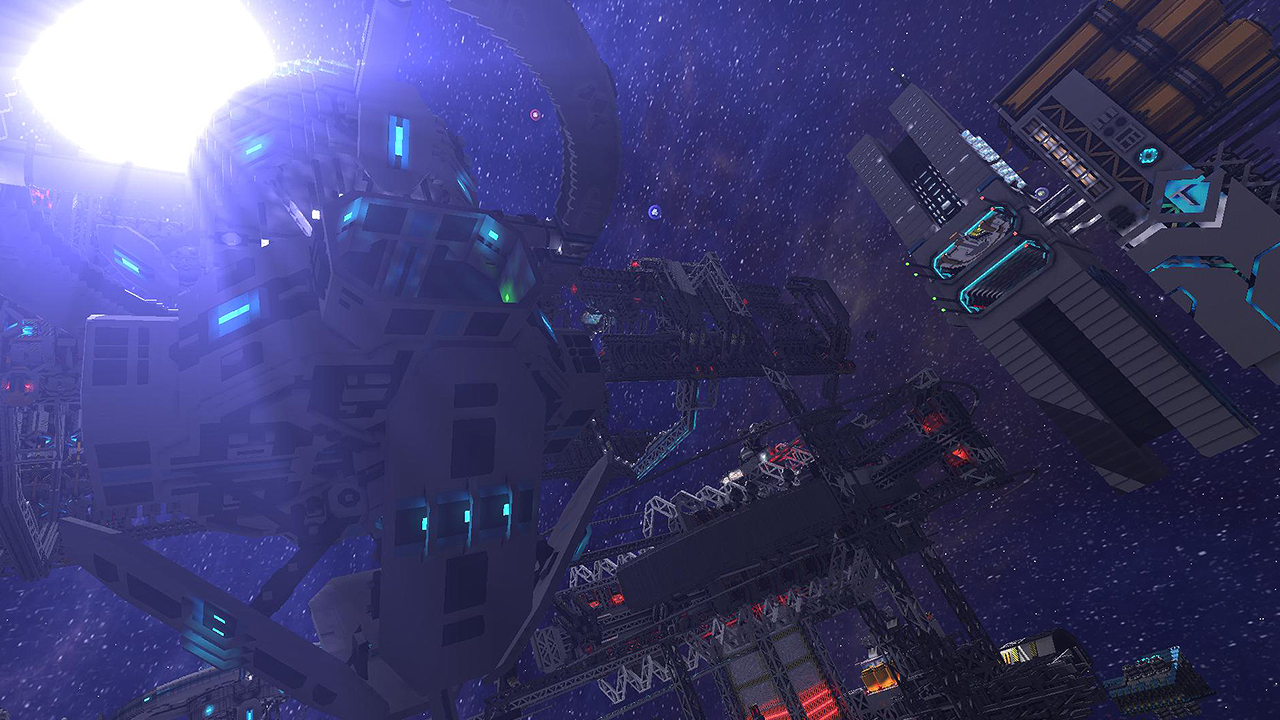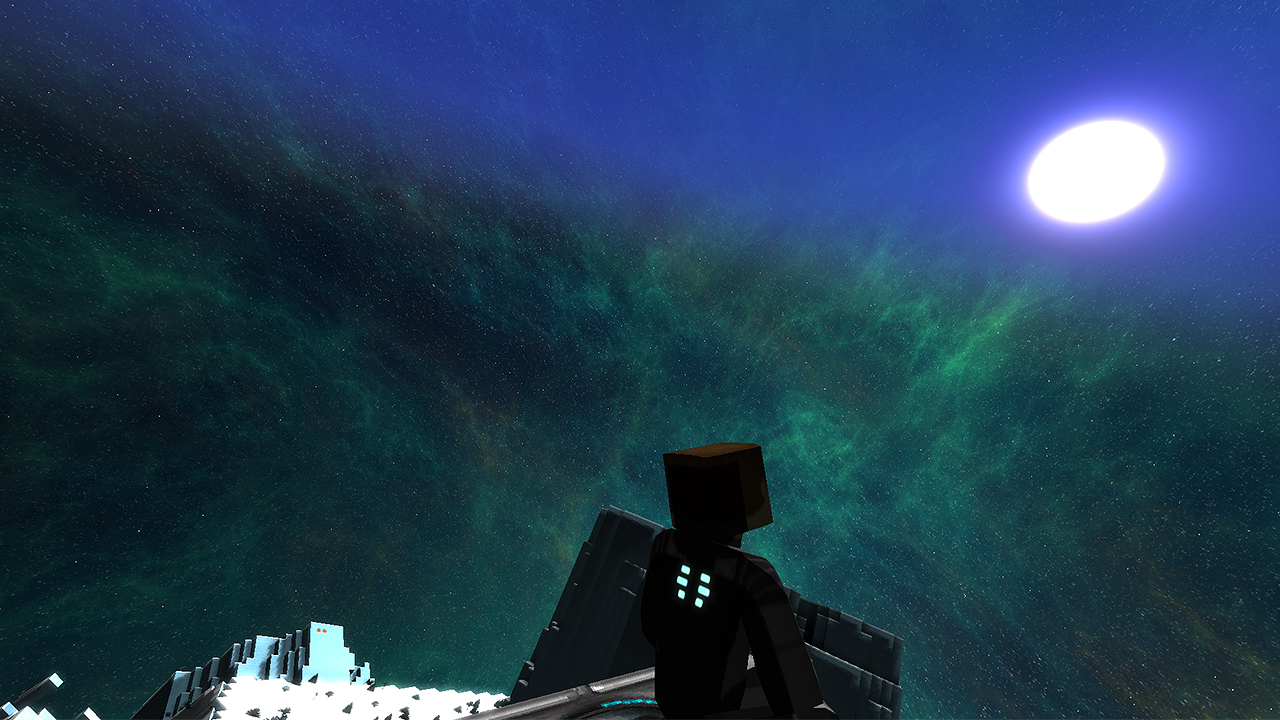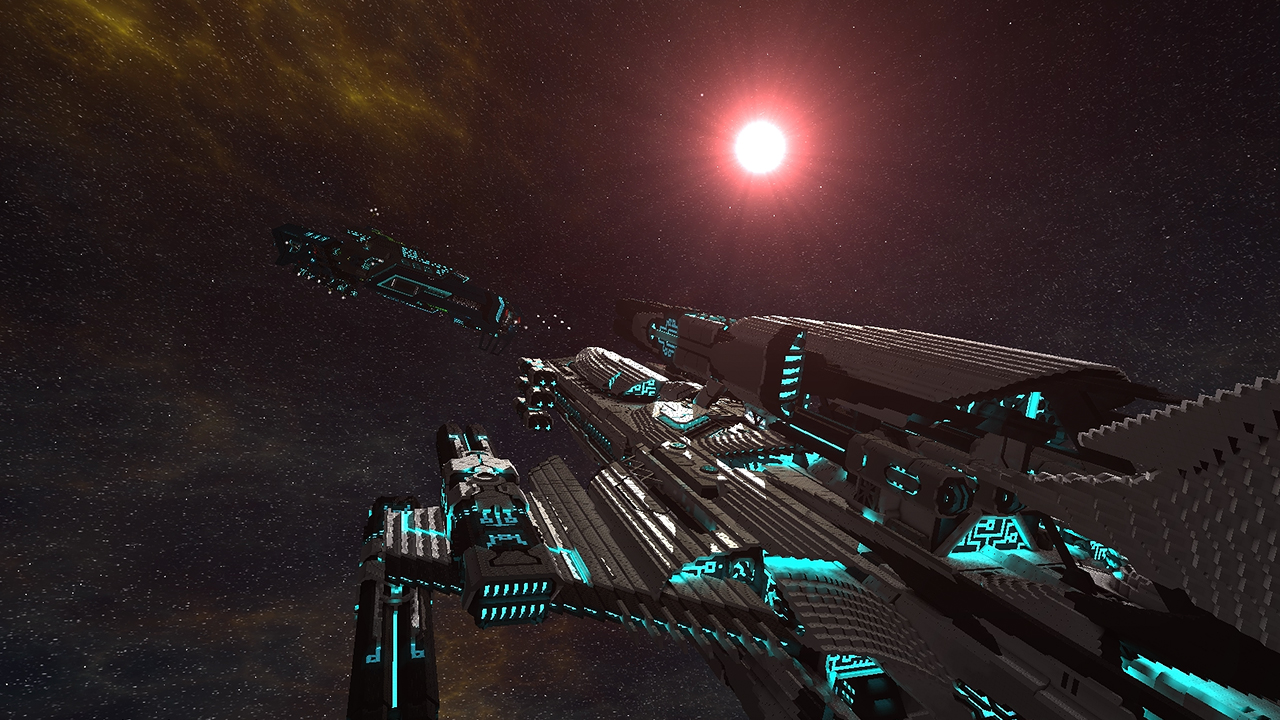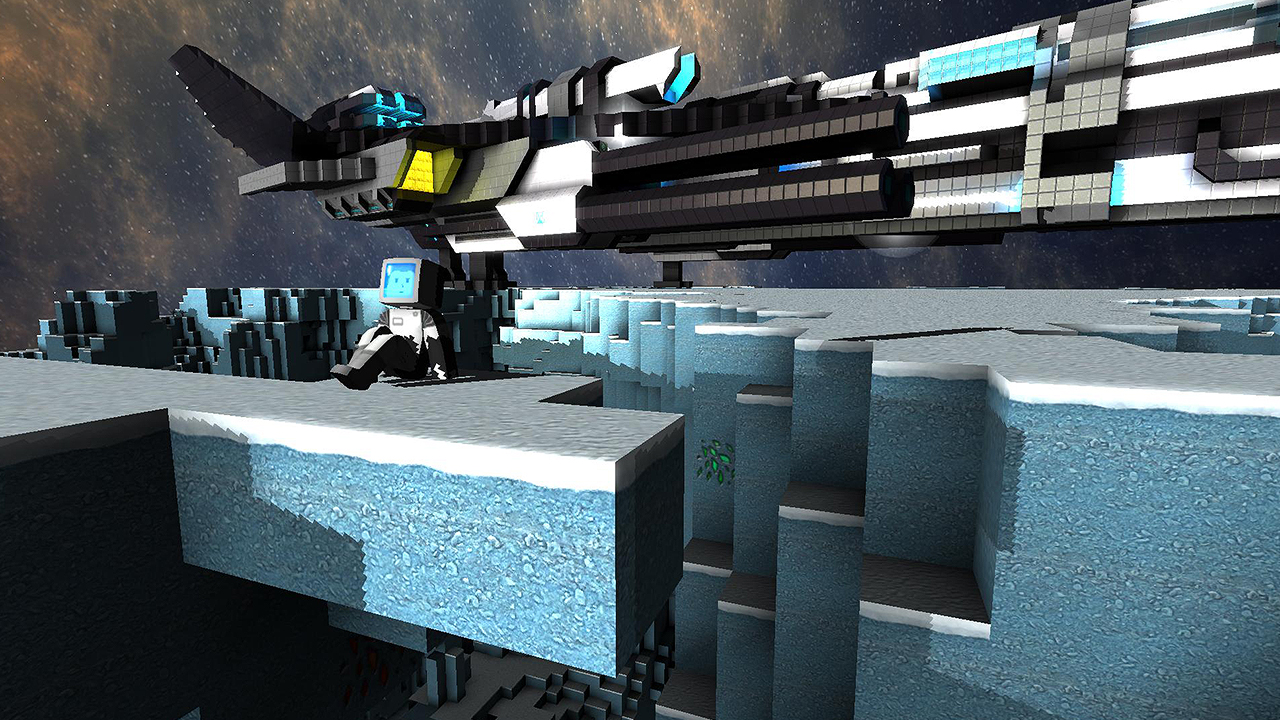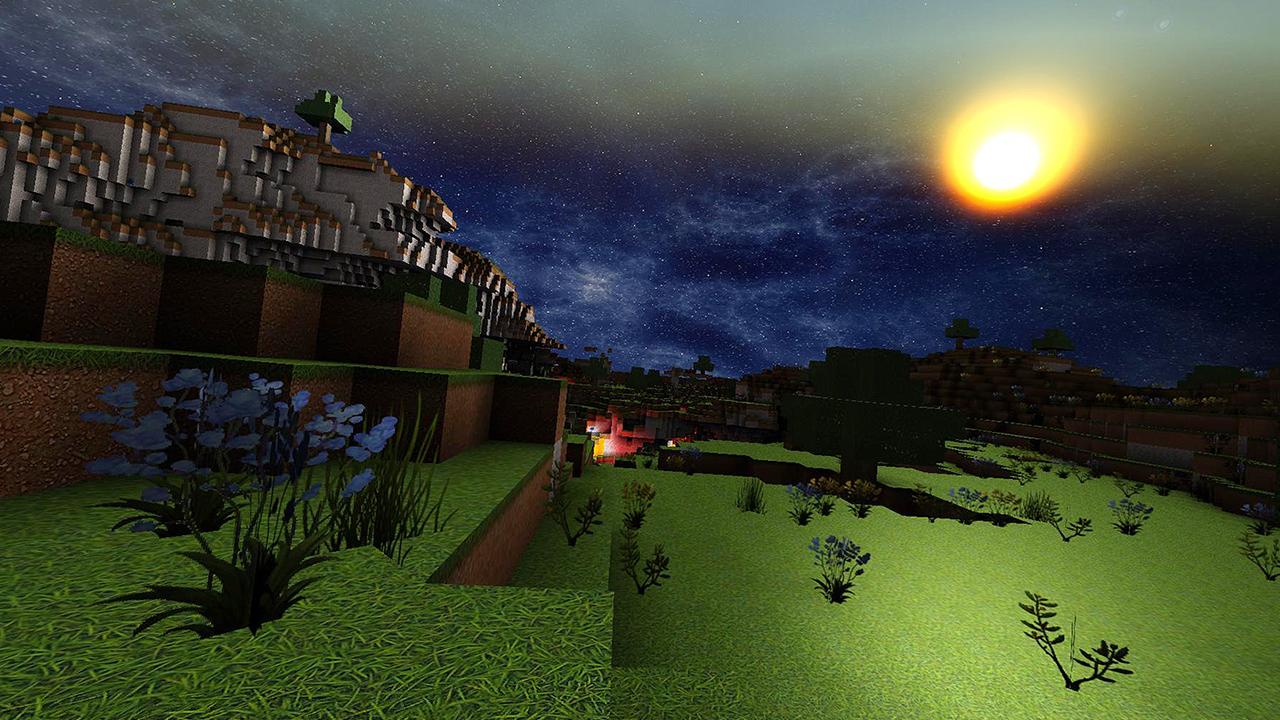A voxel-based 3D sandbox set in the never-ending darkness of space. Create your own ships, explore new galaxies, stars and planets. Discover and salvage space stations, fight against pirates or opposing factions in multiplayer. Equip your ships with completely customisable weapons and conquer the galaxy. Trade and make a fortune, mass produce materials in gigantic factories. Design your very own space station. Create warp gates and network the universe at your front door.
The universe is a vast, mystical, beautiful, awe-inspiring place.... the universe is yours.
Built for scalability to facilitate massive fully interactable objects, almost anything is possible. Gameplay elements have been skillfully constructed to bring the ultimate space sandbox experience.
Dive into your own unique universe, and choose your path.
The universe is a vast, mystical, beautiful, awe-inspiring place.... the universe is yours.
Built for scalability to facilitate massive fully interactable objects, almost anything is possible. Gameplay elements have been skillfully constructed to bring the ultimate space sandbox experience.
Dive into your own unique universe, and choose your path.
Key Features:
- Procedurally generated infinite universe, with quadrillions of galaxies - The universe is massive. It'd take approximately 10,000 years to cross from one end to the other! Singleplayer and Multiplayer worlds can be heavily customised with our extensive config options.
- Developed for scalability- We have a broad range of graphical and performance options that cater to our low-end users as well as those with heavy rigs and servers.
- Advanced Build Tools - Powerful and easy to use building tools, quickly design awesome ships, stations and bases. Including functions: Copy & paste, undo, redo, replace, symmetry modes, shape assistance systems (spheres, cycles, torus and more) and rotation of templates.
- Modular Weapon Systems - Combine weapon systems for countless configurations of weapons. From sniper beams to swarm missiles.
- Comprehensive Rail & Logic Systems - Use the rail system to build moving parts. You can do anything from simple elevators, sliding or rotating doors, to complex cranes.
Tinker with our logic systems to control any system in the game, be it weapons, lights, rails, or explosives. Logic covers all basic gate types for convenient use (AND, OR, NOT, DELAY, Flip-Flop), allows in flight control and wireless connections between entities. You can use it for simple things like timers, switches, buttons. Or, build complex systems like working clocks and even a real CPU. - Community multiplayer (dedicated servers) - Play with others in our community hosted servers. Our configs allow administrators to customise core game mechanics for a tailored experience. Most settings can be tweaked to squeeze the best performance out of hardware.
- Platform independent (Windows, Linux, Mac) - StarMade is completely platform independent. We support the three most widely used operating systems.
- Free to play in alpha - We offer the full game free to play while in alpha development. Play our game through this period for free while in return we receive invaluable feedback and bug reports.
Devblog 21st September 2017
The difference now is that we have a fully functional system in-game. What follows is a summarisation of everything that was mentioned in the stream. Keep in mind what was shown is an internal dev-build. This is a Work-in-Progress, everything is subject to change. The user-interface is for development and debugging purposes only, it requires a lot of improvements to be user-friendly.
We started with showing how to make a simple, functional reactor that provides power.

There are two block types involved, the reactor blocks on the right and their counterparts, the stabilizers on the left. Stabilizers are not required for small reactors, but are necessary for improving the efficiency of larger reactor setups.
As you can see, the stabilizers are colour coded to visualize their efficiency. Full green (most efficient) > full red (least efficient) and everything inbetween a mixture. In addition to coloring, a numerical value for stabilizer efficiency appears when looking at each block and we’ll make sure to add more context based information where needed. The distance required between these two groups depends on the size of the active reactor, and if you build stabilizers below the optimal range, they’ll lose efficiency, and you need more of them to stabilize the reactor.
The power reactor blocks can be linked to chamber blocks with conduits. There are a number of chamber types, each one of them offering effects and additional mechanics to enhance your ship/station with.

In the above example, we’ve linked the power reactor to a mobility chamber and can choose a number of effects as the first node of the mobility tree. These chamber effects can also be applied on a sector level, a crucial component for our universe update to add more interesting areas to galaxies, such as nebulae and gas giants.

Some chambers are a prerequisite for others; here we need to get an upgrade to the jump drive charge time before we can add an auto-charge mechanic to it.
These chambers use “Chamber Capacity”, a point system that is the same amount for anything that has a reactor. Each chamber has its own capacity cost, limiting the amount of active chambers you can have at the same time.
Minimum chamber size is based on your reactor size. They use a “step” system where the minimum chamber size only increases when your reactor size reaches the next step/threshold. This allows some reactor size adjustments without requiring you to change all of your current chambers. At the top of the reactor menu you can see both current reactor size and number of chamber blocks needed per chamber to function.
Something we added recently is a chamber upgrade system. Instead of making an entirely new chamber group to get a buffed version of an effect you already have, you can now simply upgrade that chamber to the next stage in the reactor menu. A Level 3 top speed chamber would have been three separate chambers before, but now you can simply upgrade it on the spot. Note that you do not need extra resources to upgrade its level, only additional Chamber Capacity.
You’re also able to switch reactors on the same ship, allowing you to have multiple chambers and power configurations with added redundancy, at the cost of extra mass and resources.
Switching reactors does take time and can leave you defenseless when done at the wrong moment.
For now, we can only switch reactors through the reactor menu, however we’ll add more options for that later in development.
The next new mechanic we demonstrated, was the power priority system and the power consumption change. Any system that consumes power has two states. A resting state where it’s not being used but can still require some power to keep itself charged; as well as a usage state, where it’s consuming power over time to reload/reset till the resting state is reached again.
For weapons, this means that you will require some power regen to keep any of them charged and ready to fire. After you’ve fired it, you’ll use more of your power reactor’s regeneration to reload the weapon.
If a system receives less power than it needs, it will still recharge but at a reduced efficiency. In case it is truly devoid of power, it will stop functioning entirely.
You can determine which systems get priority over others by simply re-ordering systems in a menu. We’ve also added a power priority option for docked ships and turrets.

Something we’re still working out is the damage system for reactors. Although conduits are required to build a functional tree, losing them in battle will not result in losing the functionality of its connected chambers.
Instead, we’re opting for a generalized Reactor HP system, similar to Structure HP we have right now. Different reactor block types will offer different HP, and losing HP will result in chambers shutting off at certain thresholds.
The last feature we demonstrated was the built-in ship systems. Any ship with a reactor now gets access to a mediocre jump-drive and a scanner. The jump-drive’s strength/speed currently scales with its reactor size and the ship’s mass. With chambers, you’re able to add extra functionality to your jump-drive such as auto-charge, power consumption efficiency changes, jump distance and amount of jumps a single charge can hold.
Jump inhibitors are similar but need a specific chamber first before it is usable. One of their final upgrades would be a jump interdiction field, dropping nearby people out of warp.
Warp gates get similar chambers, where one of the last upgrades would be the “free target” mechanic. This would allow ships passing through a warpgate to jump to any location in a set distance, even if there is no linked warpgate there. The warp gate will try its best to send you to that destination but would avoid stars and planets, even stations if there is a jump interdiction system.
Radar jammer and cloak are also built-in now but require a chamber before they’re usable. They’re combined into one functionality called the “stealth drive”, and has a limited usage time unless you upgrade it with another chamber.
You can still counter the stealth drive with your scanner, although now we use a strength system to determine what happens. Depending on the difference between your scan strength and the stealth drive’s strength, the stealth drive stops functioning completely, or partially, or is not affected at all.
The scanner, besides anti-stealth and long-range map information, also receives extra functionality for combat information. Depending on its strength and your target’s defensive measures, you gain access to different levels of vital information.
We’re still working on balance, but an example shown in the stream was system group highlighting.

Additionally, we’ve added a new config editor for chamber effects, and updated the normal block config editor for the chamber blocks, allowing anyone to tweak or add their own chambers.

Repulsor settings can be changed in the thrust configuration menu, and the repulsors themselves can be toggled on/off on your hotbar. Their strength depends on how much of your thrust you divert to them.
We’ll most likely add logic control to them too.

Why do those chamber blocks have shards?
Currently, we use the resource overlay system to show if a chamber is in use or not in our testing phase.
[/*][/*] How does this work for small fighter sized ships?
The same for any ship size, the config is made to make any volume to surface area ratio work.
[/*][/*] Can’t you make a massive weapon that can fire once?
No, each usable system requires a bare minimum of power regeneration even to fire once. There’s also a top-off rate mechanic that makes any ready to use system, consume some power still.
[/*][/*] Do you need conduits to connect a reactor with stabilizers?
No, you only need conduits to connect reactors with chambers. The stabilizers work connection free and only care about the current active reactor.
[/*][/*] Does this mean ships will become smaller than previously, as in needing less blocks?
No, you’ll just need fewer system blocks to build any of these ships.
[/*][/*] Reactors on docked entities/turrets? Power inherited from parent ship?
There can be only 1 active reactor on the entire entity, including its docks. If you dock a turret with its own reactor to a ship that already has one, the turret’s reactor will simply disable and inherit its power instead. It always looks at the root structure, if that has no power reactor, nothing docked to it will have power either.
[/*][/*] Will chambers only apply their effects when parent reactor is active?
As there can only be 1 reactor on the entire entity, its chambers will also apply for the entire entity
[/*][/*] What about jump inhibitors?
Jump Inhibitors are still available, but are now accessed through a chamber tree.
[/*][/*] How do you switch reactors?
Currently, there’s only a user interface option, but we’re planning to add more options there.
[/*][/*] Do conduits need to be orientated?
No, they only require to touch sides to form a connection.
[/*][/*] What is the motivation to actually make separate reactors when you can just put every chamber on your main reactor and not have to suffer the downtime when switching?
Scanning will not show inactive reactor groups; your other reactor may only have minimal damage.
[/*] Reactor HP is tracked for each group; you can switch if your 1st reactor is heavily damaged and get quite a lot of your original power regeneration back. Depending on the situation, the new chambers may not be initialized fast enough.
[/*] You can only have a limited amount of chambers active at the same time (determined by chamber capacity), you can have a separate offline reactor with different chambers to fit your need. An FTL specialized reactor for travelling and a Salvage specialized reactor for when you find some asteroids.
[/*][/*] Will we be able to use the old system still?
Yes, there will be a config option to disable/enable the old system. When it’s still enabled, a structure will switch over to the new system as soon as one of the new reactor blocks is used.
If the old system is disabled, all old power related system blocks will be inert and only serve as decoration.
[/*][/*] Can priorities be controlled with logic?
No, it’s not currently planned.
[/*][/*] Will we able to use logic with the chambers?
We would like to have it in some shape or form, but we’re not sure yet how as it could cause some stability/balance issues.
[/*][/*] Will there be a designated filling block?
At this stage, we don’t see the need for it. Basic hull already serves that purpose quite well but also depends on more user feedback.
[/*][/*] [/list]
Thanks for playing StarMade,
~ The Schine Team
Greetings Citizens,
One of our recent streams showcased the new Power System we’ve been working on. This is the dev blog that follows up on that. In case you’ve missed it, we’ve made a stream highlights video you can watch here: https://www.youtube.com/watch?v=jn9XRI5PVQ8
Power
Most of what we’ve shown works exactly as described here: StarMade Ship Systems 2.0The difference now is that we have a fully functional system in-game. What follows is a summarisation of everything that was mentioned in the stream. Keep in mind what was shown is an internal dev-build. This is a Work-in-Progress, everything is subject to change. The user-interface is for development and debugging purposes only, it requires a lot of improvements to be user-friendly.
We started with showing how to make a simple, functional reactor that provides power.

There are two block types involved, the reactor blocks on the right and their counterparts, the stabilizers on the left. Stabilizers are not required for small reactors, but are necessary for improving the efficiency of larger reactor setups.
As you can see, the stabilizers are colour coded to visualize their efficiency. Full green (most efficient) > full red (least efficient) and everything inbetween a mixture. In addition to coloring, a numerical value for stabilizer efficiency appears when looking at each block and we’ll make sure to add more context based information where needed. The distance required between these two groups depends on the size of the active reactor, and if you build stabilizers below the optimal range, they’ll lose efficiency, and you need more of them to stabilize the reactor.
The power reactor blocks can be linked to chamber blocks with conduits. There are a number of chamber types, each one of them offering effects and additional mechanics to enhance your ship/station with.

In the above example, we’ve linked the power reactor to a mobility chamber and can choose a number of effects as the first node of the mobility tree. These chamber effects can also be applied on a sector level, a crucial component for our universe update to add more interesting areas to galaxies, such as nebulae and gas giants.

Some chambers are a prerequisite for others; here we need to get an upgrade to the jump drive charge time before we can add an auto-charge mechanic to it.
These chambers use “Chamber Capacity”, a point system that is the same amount for anything that has a reactor. Each chamber has its own capacity cost, limiting the amount of active chambers you can have at the same time.
Minimum chamber size is based on your reactor size. They use a “step” system where the minimum chamber size only increases when your reactor size reaches the next step/threshold. This allows some reactor size adjustments without requiring you to change all of your current chambers. At the top of the reactor menu you can see both current reactor size and number of chamber blocks needed per chamber to function.
Something we added recently is a chamber upgrade system. Instead of making an entirely new chamber group to get a buffed version of an effect you already have, you can now simply upgrade that chamber to the next stage in the reactor menu. A Level 3 top speed chamber would have been three separate chambers before, but now you can simply upgrade it on the spot. Note that you do not need extra resources to upgrade its level, only additional Chamber Capacity.
You’re also able to switch reactors on the same ship, allowing you to have multiple chambers and power configurations with added redundancy, at the cost of extra mass and resources.
Switching reactors does take time and can leave you defenseless when done at the wrong moment.
For now, we can only switch reactors through the reactor menu, however we’ll add more options for that later in development.
The next new mechanic we demonstrated, was the power priority system and the power consumption change. Any system that consumes power has two states. A resting state where it’s not being used but can still require some power to keep itself charged; as well as a usage state, where it’s consuming power over time to reload/reset till the resting state is reached again.
For weapons, this means that you will require some power regen to keep any of them charged and ready to fire. After you’ve fired it, you’ll use more of your power reactor’s regeneration to reload the weapon.
If a system receives less power than it needs, it will still recharge but at a reduced efficiency. In case it is truly devoid of power, it will stop functioning entirely.
You can determine which systems get priority over others by simply re-ordering systems in a menu. We’ve also added a power priority option for docked ships and turrets.

Something we’re still working out is the damage system for reactors. Although conduits are required to build a functional tree, losing them in battle will not result in losing the functionality of its connected chambers.
Instead, we’re opting for a generalized Reactor HP system, similar to Structure HP we have right now. Different reactor block types will offer different HP, and losing HP will result in chambers shutting off at certain thresholds.
The last feature we demonstrated was the built-in ship systems. Any ship with a reactor now gets access to a mediocre jump-drive and a scanner. The jump-drive’s strength/speed currently scales with its reactor size and the ship’s mass. With chambers, you’re able to add extra functionality to your jump-drive such as auto-charge, power consumption efficiency changes, jump distance and amount of jumps a single charge can hold.
Jump inhibitors are similar but need a specific chamber first before it is usable. One of their final upgrades would be a jump interdiction field, dropping nearby people out of warp.
Warp gates get similar chambers, where one of the last upgrades would be the “free target” mechanic. This would allow ships passing through a warpgate to jump to any location in a set distance, even if there is no linked warpgate there. The warp gate will try its best to send you to that destination but would avoid stars and planets, even stations if there is a jump interdiction system.
Radar jammer and cloak are also built-in now but require a chamber before they’re usable. They’re combined into one functionality called the “stealth drive”, and has a limited usage time unless you upgrade it with another chamber.
You can still counter the stealth drive with your scanner, although now we use a strength system to determine what happens. Depending on the difference between your scan strength and the stealth drive’s strength, the stealth drive stops functioning completely, or partially, or is not affected at all.
The scanner, besides anti-stealth and long-range map information, also receives extra functionality for combat information. Depending on its strength and your target’s defensive measures, you gain access to different levels of vital information.
We’re still working on balance, but an example shown in the stream was system group highlighting.

Additionally, we’ve added a new config editor for chamber effects, and updated the normal block config editor for the chamber blocks, allowing anyone to tweak or add their own chambers.

Repulsors
While working on the power system, we had the idea to add a new functional block to the game, something that was extremely fast to implement (although not as fast to balance). The new Repulsor block uses your onboard thrust to provide a push force on itself, allowing you to effectively hover your ship in a gravity well. We demonstrated this on a planet. They also work outside of a gravity source as then the repulsors function slightly different to make sure they also push you down when you’re getting further away from a surface.Repulsor settings can be changed in the thrust configuration menu, and the repulsors themselves can be toggled on/off on your hotbar. Their strength depends on how much of your thrust you divert to them.
We’ll most likely add logic control to them too.

FAQ
- Does the chamber <-> reactor distance requirement also work in a diagonal direction as well as a straight line?
[list] - Yes.
[/*]
[/*][/*]
[/*][/*]
[/*][/*]
[/*][/*]
[/*][/*]
[/*][/*]
[/*][/*]
[/*][/*]
[/*][/*]
[/*][/*]
[/*]
[/*]
[/*][/*]
If the old system is disabled, all old power related system blocks will be inert and only serve as decoration.
[/*][/*]
[/*][/*]
[/*][/*]
[/*][/*]
Thanks for playing StarMade,
~ The Schine Team
[ 2017-09-21 15:22:55 CET ] [Original Post]
Minimum Setup
- OS: Ubuntu 14.04 - 64 bit
- Processor: Intel Core i3 (2nd Generation and above) | AMD FX 6xxx or equivalentMemory: 4 GB RAM
- Memory: 4 GB RAM
- Graphics: Nvidia GeForce GTX 260. 275. 280. 460 SE. 550 Ti | AMD Radeon HD 4870. 5770. 4890. 5830. 6770. 6790 or equivalent with OpenGL 2.1Network: Broadband Internet connection
- Storage: 3 GB available spaceAdditional Notes: 2GB of memory must be available for StarMade. Lower specs may work by modifying graphics and other performance options. Try out our demo to get an indication for your system. System components such as Integrated Graphics cards may not be supported. Requirements may change in further updates.
Recommended Setup
- OS: Ubuntu 15.04 - 64 bit
- Processor: Intel Core i7-2600 @ 3.4 GHz | AMD FX-8320 Eight-Core @ 3.5 GHz or equivalentMemory: 8 GB RAM
- Graphics: Nvidia GeForce GTX 560. 650 Ti. 750 | AMD Radeon HD 5850. 6870. 7790 (or equivalent)Network: Broadband Internet connection
- Storage: 3 GB available space
GAMEBILLET
[ 6450 ]
GAMERSGATE
[ 4222 ]
MacGamestore
[ 5361 ]
FANATICAL BUNDLES
HUMBLE BUNDLES
by buying games/dlcs from affiliate links you are supporting tuxDB

